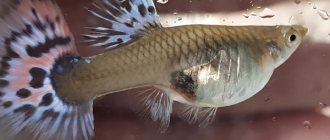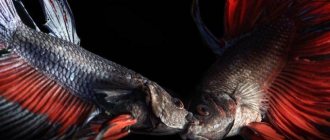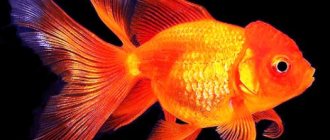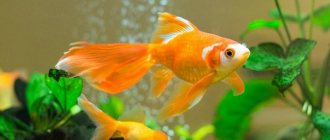Swordtail
fish
What to do if the fish behaves unusually, try to watch it as carefully as possible and take a good look at it from all sides, perhaps even using a magnifying glass. Why is this necessary? So that when reading this article, you can determine as accurately as possible the reason why your swordtail lies at the bottom of the aquarium. There can be many reasons for this; let’s look at each in detail.
Description of the species
The first migration of swordtails to the aquarium took place back in 1864. Thanks to the scientist Heller, from Germany, they successfully crossed from South American waters to European laboratories, and also received their name Xiphophorus helleri (translated from Latin Heller's swordtail).
Belonging to the Poeciliidae family, the fish have differences in appearance between the female and the male. The sexual characteristics of the male are the presence of a sword-like rear fin. The elongated body has a slight compression on the sides. Since both in nature and in a domestic reservoir, feeding occurs from above, the fish have a formed mouth, turned up, for convenient intake of food.
The male's body is slightly smaller than that of the female. The structure of the anal fin also differs between the sexes. The maximum body length in a female can reach 8–10 cm, in a male it is 2 cm less. The homeland of the swordtail has a predominantly warm climate, so the optimal water temperature for this species of ray-finned fish must also meet these requirements (more on this below).
If the number of females in the reservoir dominates, then they can change sex. A sword-like fin grows on the caudal fin and the anal rounded fin turns into a gonopodium - flat and sharp. Mutated individuals are even able to perform their sexual function, but more than half of the offspring in this case will be female.
We talk more about the reproduction of swordtails in a separate article.
The multi-colored bright coloration was developed as a result of laboratory research, in the process of crossing them with other species of poeciliids. The color can vary significantly: lemon yellow, red, spotted or even black.
In nature, these individuals are not found in any other color other than green.
Homeland of the fish
The fish's homeland is in fresh water bodies of South America, Mexico, Honduras or Guatemala, where the current is slow or completely absent.
Articles on the topic
Columnaria in fish - treatment in a community aquarium and the reasons for its appearance What to do if a goldfish swims upside down Hexamitosis in fish - symptoms, causes and treatment Ichthyophthyriosis (semolina in aquarium fish) and its treatment
The swordtail is one of the most famous aquarium fish, because it has been kept in amateur aquariums for many years. The fish is valued primarily for its unpretentiousness, bright coloring and unusual body shape (the presence of a “sword” on the tail) and, of course, for the ease of breeding at home.
Like other representatives of the Poeciliaceae family, swordtails are viviparous fish. This means that the female gives birth to a fully formed fry, capable of independent feeding. Fertilization of the eggs occurs inside the female's body, and the eggs develop in the female's genital tract.
Compatibility
Compatibility with other fish is good. They can live with other representatives of their kind and even predatory catfish are not afraid of them. Although males can be aggressive among themselves. But this behavior is more often characterized by competition for the female, both in nature and in the aquarium; reproduction remains in first place. In order for the males to get along with each other, it is not necessary to place only two individuals in the reservoir; it is better to have more of them, but the number of females in the aquarium should be equal to them. They will not get along only with those aggressive and predatory waterfowl that are larger than them and can simply eat small fish. These could be cichlids, which include acara or astronotus.
Pregnancy and childbirth
Often, fish lie to the bottom before giving birth, this behavior is especially typical for viviparous breeds, therefore, if there is a pregnant female swordtail at the bottom of the aquarium, set her aside to produce offspring.
The process of giving birth to small fish can take more than one day; all this time the female needs care and increased attention. Immediately after giving birth, it must be returned to the general aquarium so that the mother does not eat her babies.
Maintenance and care
Swordtails are fish that are loved by aquarium owners for their ease of care. The homeland of the fish is South America and therefore an aquarium with swordtails must meet several simple requirements:
- the water temperature should be maintained at 20–26 °C, with a maximum and short-term decrease of perhaps up to 15 °C;
- the acidity of the water should be at a level of 7–8 pH, which can be easily determined using special test strips;
- control of water hardness, which can range from 8 to 25 DH;
- provide aeration and water purification;
- carry out a standard water change of 1/3 of the total volume.
Aquarium swordtail fish can live in both salt and fresh water, so aquarium water can be salty in order to get along with other inhabitants. Caring for swordtails does not require effort; the main thing here is not to overdo it and remember that these fish do not like light, they are accustomed to living among dense thickets.
Age
No matter how sad it may be, even with good care, swordtails live in an aquarium from 3 to 6 years, when the time comes for the fish to lie down on the bottom and gradually fade away.
Other interesting articles
- Large, medium and small peaceful fish for the aquarium Among various types of pets, aquarium fish are especially popular. They are relatively inexpensive, not...
- How many years do fish live? One of the most important questions that concerns any aquarist is how many years do aquarium fish live? Answer…
- Aquarium fish in a pond After arranging a pond, almost every person has a desire to revive it by adding fish there. Exists…
Feeding
There is no need to purchase special feed. Fish can eat “from the common table”, along with all other inhabitants of the reservoir. A varied diet will allow them to develop, grow active and healthy.
When feeding swordtails, there are several options to consider:
- Specialized dry food, frozen bloodworms or daphnia.
- Self-prepared food from plant ingredients - seaweed or spinach, as well as nettle or lettuce leaves scalded with boiling water to soften.
- Additional feeding in the form of boiled egg yolks or crushed crackers.
It is also better to maintain a regular feeding regime, since the swordtail is a voracious fish. A few days of diet will be useful and will help avoid the occurrence of the disease against this background. After abstinence, it is better to start feeding slowly so as not to provoke overeating.
In the absence of a filter, you need to remove the remaining food yourself, otherwise the water will quickly deteriorate, and for swordtails, as for other species of poeciliids.
Fry
How many fry do swordtails give birth to?
Female swordtails, especially those that have already bred several times, are very fertile. If a young female can limit herself to giving birth to 15 fry, then a “seasoned” female can easily give you several hundred babies.
After “giving birth,” the female should be removed from the spawning tank or hatchery, because the fact that swordtails eat their fry has long been known. Perhaps the preservation and feeding of young individuals is the most difficult thing in breeding swordtails.
The moment of birth of a fully formed swordtail fry
How to determine the sex of swordtail fry
As with adults, to determine the sex of swordtail fry, attention should be paid to the presence of gonopodium. In most cases, it is formed at the age of about 3-4 months.
The first days of the fry
Swordtail fry emerge fully formed and ready to feed on their own. Their size is about 1 cm. This is in contrast to spawning fish, in which a larva first hatches from the eggs, eats the yolk sac for several days, and only then an independent fry is formed.
The most important thing at this time is to ensure the safety of the fish, especially if they appeared in a common aquarium - this requires shelter and living plants. In a breeding aquarium, simply removing the female is sufficient.
What to feed the fry
Due to their large size, swordtail fry are able to immediately eat fairly large foods. For example, a specialized food for juvenile ornamental fish – TetraMin Baby – is perfect. Thanks to its high nutritional value, vitamin complex and preobiotic, it ensures healthy growth of fry. Micro flakes are perfectly eaten by fry of viviparous fish. Babies should be fed frequently - 4-6 times a day.
How long do fry grow?
With the right diet and regular aquarium maintenance, swordtail fry grow very quickly. By three months, some individuals begin to develop a “sword”, and after another 4-5 months the fish are quite capable of reproducing. To prevent accidental crossing, it is better to separate males and females as early as possible.
The calling card of the male swordtail – “sword” – appears at the age of about three months
It is best to select the brightest and strongest individuals as breeders. It is worth noting that all forms of swordtails are capable of interbreeding with each other, making it very easy to get interesting offspring even at home.
Diseases
Diseases of swordtails occur rarely. But still, if the owner does not care enough, this unpretentious swordtail fish can get sick. Also, infections can get into the water with food, which can subsequently make the aquarium resident sick, and the appearance of the individual will immediately tell about this.
You can determine that your pet is unhealthy based on several signs:
- the swordtail lies on the bottom or is frozen in one place;
- the fish looks restless, rubs against the stones, randomly rushes around the pond, sways;
- no appetite;
- the abdomen swells;
- fins folded;
- white or cloudy spots on the body;
- pieces of gun.
Purchasing new pets should be done responsibly and carefully. For example, the presence of a rash or sores, a small fuzz on the body or plaque indicates that a new swordtail in the aquarium will cause illness in other individuals.
The swordtail is susceptible to disease and fungal disease. Treatment in this case is simple if the reservoir contains only those fish that can survive in salt water. For every one liter of aquarium you need to dilute one level tablespoon of salt.
If the swordtail lies on the bottom or is frozen, then this may indicate not only the introduction of any infections with food, but also the hypothermia of the individual. A cold will go away in a few days if you always make sure that the water does not cool below the normal level for this type.
What fish like to swim on the bottom?
Bottom fish:
- Catfish.
- Ancistrus.
- Corridor.
- Agamixis.
- Bocia.
- Loach breeds.
- Acantophthalmus.
- Greenocheilus.
Unpretentious waterfowl take root well, do not conflict with neighbors, the size of the aquarium acceptable for different species and the properties of the water differ.
Shelters and burrows are built in the sand, and algae with strong roots are used.
Feeders are made from a plastic bottle - the top part is cut off, a hose is inserted into it to form a funnel, and dry food is sent there.
The tube is placed in the water, food is selected separately for each species.
Girinocheilus consumes vegetation, lettuce, and spinach.
Chukuchans prefer live food, bloodworms, and tubifex worms.
| Visitor |
| Modified 5/25/10 by Freeangels |
| Regular |
What exactly is the nature of the curvature? Is there a plaque (can only be seen from a certain angle)? Does the fish eat or not? What is the water temperature? What do you feed? How long have these symptoms been? Can you take a photo? |
| Visitor |
Modified 5/25/10 by Freeangels |
| Regular |
I hope the jar is at least three liters? Try some salt (a teaspoon per 10 liters). Raise the temperature slightly (26-27). Replace the water in the jar with settled water more often. Wait and watch. If there is a deterioration, go to the disease section. Consider including live or at least frozen food in your fish's diet. Don't feed the fish too much now. |
| Regular customer |
Salt won't help here. And what to expect and what to watch? |
| Visitor |
| Regular customer |
Euthanasia. Modified 5/26/10 by arctic |
| Visitor |
I'll do without it, thanks |
| Regular customer |
| Scoliosis, or curvature of the spine, can occur in fish during closely related breeding, after feeding a pregnant female with dry food (the normal development of the egg is disrupted), during oxygen starvation (the aquarium contains a lot of fish or the aquarium water is not enriched with oxygen), after the removal of fry (the result intra-abdominal pressure). Treatment: treatment for sick fish has not been developed, and in order to prevent the disease, inbreeding of fish should not be allowed; it is recommended to maintain optimal conditions for keeping fish in the aquarium from an early age. |
| Visitor |
| Sometimes he hides in a corner, sometimes he lies head down at the bottom ( |
| Visitor |
With such twisted fish, I have not found a single method of treatment, although I experimented on several fish. Improving conditions and salt will not help. The toilet will ease the suffering for both you and the fish. |
Why do swordtails die? The swordtail lies on the bottom
The death of a swordtail is not only an offensive loss, but also a reason to think about what could have caused the death of the fish. After all, most often such a disastrous end is caused by a disease that can easily spread throughout the entire aquarium.
Therefore, the first thing to do is change the water in it. And then, in order to protect the rest of the aquarium inhabitants, it is necessary to understand the reasons that led to the death of the first fish and try to eliminate them.
The most common diseases
The reasons why swordtails die can be very different - ranging from poor water quality to natural death. Even if before the incident the fish felt good in settled tap water, the slightest change in its composition could negatively affect the health of the aquarium inhabitants. An increase in nitrates and other chemicals contained in water can immediately cause deterioration in the condition of the fish and even lead to their death.
It is also worth considering that swordtails live up to five to six years, after which owners should be prepared for the death of the fish.
Infectious diseases also often cause the death of aquarium inhabitants. It is very simple to determine that a swordtail is sick. He becomes lethargic, stops responding to external stimuli and begins to stay closer to the bottom. If we are talking about erosion of the fins or “fin rot”, then to the listed signs there is also a deterioration in the appearance of the fins: they become frayed and frayed. There are also infections in which microbes infect the gills of fish. Usually this kind of disease spreads to all fish in the aquarium.
Conditions for reproduction
In order to get offspring of swordtails, there is absolutely no need to make serious efforts. These fish reproduce well even in community aquariums and do not require special conditions.
All that is required is a couple of manufacturers. One male is capable of fertilizing several females, so ideally swordtails should be kept in harems, in which there are 2-3 females per male.
In order to get the maximum number of fry, you should acquire a separate spawning aquarium or a hatchery in which females are placed that are ready to give birth. In the first case, it is recommended to place more small-leaved plants in the container - Java moss, hornwort, elodea, etc. These species will be an excellent shelter for the fry, which the new mother can easily snack on. When breeding swordtails in a community aquarium, you should also provide a large number of hiding places for the babies. Otherwise, they may be eaten by their tankmates.
To obtain offspring, it is best to use fish that are about 8 months old. In practice, fish can reproduce at an earlier age, but in this case the offspring are unlikely to be of high quality. Spawning usually occurs in the morning hours. Males chase females and perform dances in front of them in the form of shuttle movements back and forth.
A shared aquarium is not an obstacle to breeding swordtails
The incentive for reproduction is abundant feeding with high-quality food, as well as maintaining comfortable water parameters: T = 26-28 ° C, pH = 7.0-8.0 and GH = 10-12.
It should be noted that among swordtails the sex ratio of the fry born depends on the water temperature. At temperatures below 24°C you will get more females, and if it gets closer to 30°C you will get more males.
If the female is ready to reproduce, then with the help of a special tubular reproductive organ - the gonopodium - the male introduces his milk into the cavity of her body. Fertilization occurs and the eggs begin to develop, so that after 40-50 days fully formed fry are born.
Interesting fact: females have a way of preserving the male’s reproductive products for a long time, gradually fertilizing the eggs. A similar adaptation was developed in fish as a reaction to unfavorable environmental parameters, and allows swordtails to wait for more comfortable conditions for the birth of fry.
A female ready to give birth should be removed. Depending on the age and physiological state of the female, she is able to spawn from 15 to 200 fry.
Individual diseases
But there are cases when only one swordtail lies at the bottom and feels bad. This may mean that he was attacked by other fish. Too persistent and violent courtship of the male also often ends in failure for the female.
Another reason for lethargy in fish may be the development of swim bladder dysfunction. In most cases, this disease is fatal.
A sharp change in water temperature can also provoke a deterioration in the swordtail’s condition. Therefore, it is necessary to avoid hypothermia and overheating of the fish, and change the water gradually. In addition, swordtails with large black spots are more susceptible to developing malignant tumors than others, so if there is the slightest change in the behavior of the fish, it is better to put it in a separate container.











